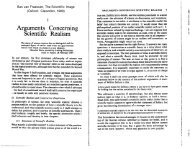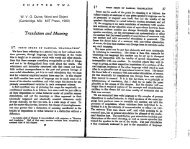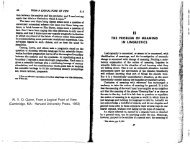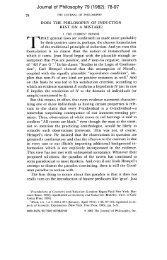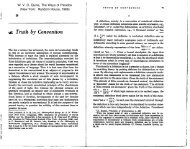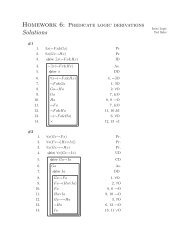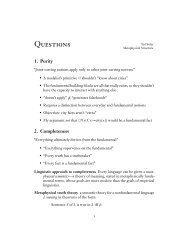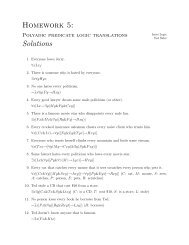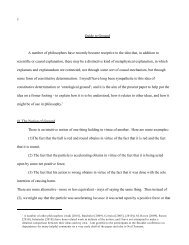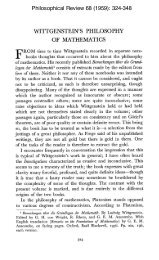Suppes and Zinnes - basic measurement theory.pdf - Ted Sider
Suppes and Zinnes - basic measurement theory.pdf - Ted Sider
Suppes and Zinnes - basic measurement theory.pdf - Ted Sider
Create successful ePaper yourself
Turn your PDF publications into a flip-book with our unique Google optimized e-Paper software.
BASIC MEASUREMENT THEORY<br />
One might be tempted to conjecture that the first four axioms of Def. I 6<br />
would characterize all finite difference systems for which a numerical<br />
representation could be found (the representations of a given system<br />
would not necessarily be related by a linear transformation). The resulting<br />
<strong>theory</strong> would then represent one forma1ization of Coombs' ordered metric<br />
scale. However, Scott <strong>and</strong> <strong>Suppes</strong> (1958) have proved that the <strong>theory</strong> of<br />
all representable finite difference systems is not characterized by these<br />
four axioms <strong>and</strong>, worse still, cannot be characterized by any simple finite<br />
list of axioms.<br />
The f. d. systems are not as artificial or as impractical as they may seem.<br />
One <strong>theory</strong> for approximating these systems is to be found in Davidson,<br />
<strong>Suppes</strong>, & Siegel (1957, Chapter 2). However, these systems can have<br />
more general usefulness if they are used to establish a "st<strong>and</strong>ard set" of<br />
stimuli. In the case of tones, for example, a set of tones may be selected in a<br />
successive manner so that the set satisfies Axiom 5. If this st<strong>and</strong>ard set of<br />
tones also satisfies the remaining four axioms, then we know from Theorem<br />
IS that the tones may be assigned numbers that are on an interval scale.<br />
Arbitrary tones that are not in the st<strong>and</strong>ard set but that satisfy the first<br />
four axioms may then be located within intervals bounded by adjacent<br />
tones in the st<strong>and</strong>ard set. This means that by decreasing the spacing<br />
between the st<strong>and</strong>ard tones any arbitrary tone may be measured within<br />
any desired degree of accuracy. This is in fact what a chemist does in<br />
using a st<strong>and</strong>ard set of weights <strong>and</strong> an equal arm balance to determine<br />
the weight of an unknown object. His accuracy of <strong>measurement</strong> is limited<br />
by the size of the smallest interval between the st<strong>and</strong>ard weights or, if he<br />
also uses a rider, by the gradations on the rider.<br />
Other relational systems closely related to f.d. systems may appropriately<br />
be mentioned at this point. Among the simplest <strong>and</strong> most appealing are<br />
the bisection systems "21 = (A, B), where B is a ternary relation on the set<br />
A with the interpretation that B(a, b, c) if <strong>and</strong> only if b is the midpoint of<br />
the interval between a <strong>and</strong> c. The method of bisection, which consists in<br />
finding the midpoint b, has a long history in psychophysics. The formal<br />
criticism of many experiments in which it has been used is that the variety<br />
of checks necessary to guarantee isomorphism with an appropriate<br />
numerical system is not usually performed. For example, if B(a, b, c)<br />
implies that aPb <strong>and</strong> bPc, where P is the usual ordering relation, then<br />
from the fact that B(a, b, c), B(b, c, d), <strong>and</strong> B(c, d, e) we should be able to<br />
infer B(a, c, e). But the explicit test of this inference is too seldom made.<br />
Without it there is no real guarantee that a subjective scale for a stimulus<br />
dimension has been constructed by the method of bisection.<br />
Because of the large number of axiomatic analyses already given in this<br />
section, we shall not give axioms for bisection systems. The axioms in<br />
1.<br />
.(.<br />
.•<br />
'EXAMPLES OF FUNDAMENTAL MEASUREMENT<br />
:any case are rather similar to those of Def. 16, <strong>and</strong> the formal connection<br />
between the difference relation D <strong>and</strong> the ternary bisection relation B<br />
should be obvious:<br />
B(a, b, c) if <strong>and</strong> only if abDbc <strong>and</strong> be Dab.<br />
As an alternative to giving general axioms for bisection systems, it may<br />
be of some interest to lqok at the problem of characterizing these systems<br />
in a somewhat different manner, namely, by simply listing for a given<br />
number n of stimuli the relations that must hold. In perusing this list it<br />
should be kept in mind that we assume that bisection systems have the<br />
same property of equal spacing possessed by f. d. systems. As examples,<br />
let us consider the cases of n = 5 <strong>and</strong> n = 6.<br />
For n = 5; let A= {a, b, c, d, e) with the ordering aPbPcPdPe. We<br />
then have exactly four instances of the bisection relation, namely, B(a, b, c),<br />
B(b, c, d), B(c, d, e), <strong>and</strong> B(a, c, e).<br />
For n = 6, we may add the element f to A with the ordering<br />
aPbPcPdPePf To the four instances of the bisection relation for n = 5,<br />
we now add two more, namely, B(d, e,f) <strong>and</strong> B(b, d,f). We may proceed<br />
in this manner for any n to characterize completely the bisection system<br />
with n stimuli, none of which is equivalent with respect to the property<br />
being studied. Establishing the representation <strong>and</strong> uniqueness theorems<br />
is then a trivial task. The disadvantages of this approach to characterizing<br />
those relational systems for which numerical representation theorems<br />
exist are twofold. In the first place, in contrast to the statement of general<br />
:axioms, the listing of instances does not give us general insight into the<br />
structure of the systems. Second, for systems of <strong>measurement</strong> that have a<br />
more complicated or less sharply defined structure than bisection systems,<br />
the listing of instances can become tedious <strong>and</strong> awkward-semiorders<br />
:provide a good example.<br />
3.5 Extensive Systems<br />
We consider next a relational system leading to a ratio scale. Since this<br />
relational system contains an operation a that corresponds to an addition<br />
operation, we may justifiably call this system an extensh'e system (see<br />
Sec. 1.4). The axioms that we shall use to define an extensive system<br />
(<strong>Suppes</strong>, 1951) are similar to those first developed by Holder (1901).<br />
HOlder's axioms, however,. are more restrictive than necessary in that they<br />
require the homomorphic numerical relational systems to be nondenumerable<br />
(<strong>and</strong> nonfinite). The present set of axioms applies both to<br />
denumerable <strong>and</strong> nondenumerable but infinite relational systems.



